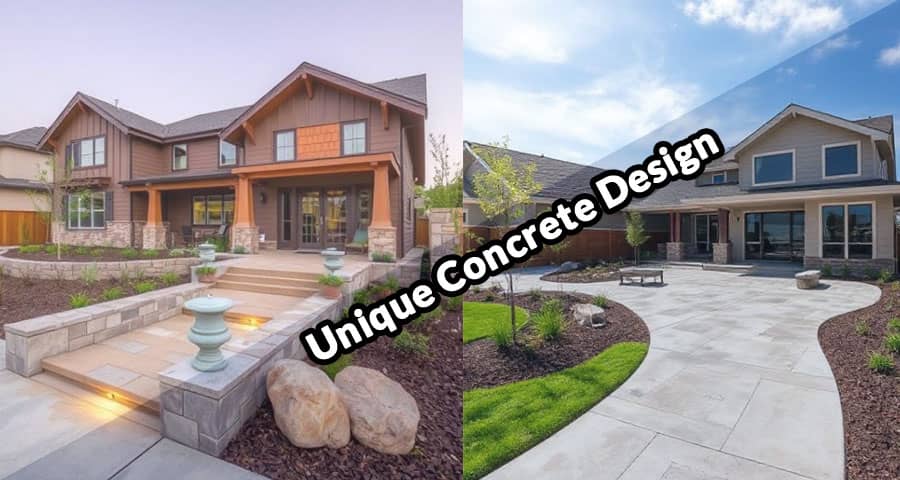What is Unique Concrete Design?

Unique concrete design is a progressive architectural and engineering approach that redefines the traditional application of concrete. It emphasizes aesthetic innovation, custom textures, color integration, and structural artistry, transforming an otherwise standard material into a design statement. This evolution has been driven by advancements in concrete technology, including high-performance mixes, decorative finishes, and form flexibility. Unique concrete design bridges the gap between functionality and creativity, offering unmatched versatility for both residential and commercial projects.
The Evolution of Concrete as a Design Material
Historically, concrete has been valued for its strength, durability, and cost-efficiency. However, modern design trends have elevated its role into a creative medium. Through techniques like polished concrete, stamped patterns, colored aggregates, and GFRC (Glass Fiber Reinforced Concrete), designers now craft spaces that are not only structurally sound but also visually compelling. Concrete is no longer just gray and utilitarian - it is now customizable, expressive, and luxurious.
Key Characteristics of Unique Concrete Design
1. Custom Finishes and Surface Treatments
The hallmark of unique concrete design lies in its surface expression. Finishes can range from smooth, mirror-like polish to rugged, exposed aggregate. Other popular treatments include:
- Stamped concrete, mimicking stone, brick, or wood
- Sandblasting and acid-etching for textured effects
- Color staining and integral pigmentation for visual diversity
- Engraving and scoring to create bespoke patterns
These techniques make each concrete installation distinctive, tailor-made, and memorable.
2. Integration of Color and Texture
Concrete's ability to take on vibrant hues and multi-dimensional textures adds a dynamic visual impact. With integral colorants, dyes, and surface stains, designers can achieve a wide palette - from earth tones to bold primary colors. Textures may emulate natural stone, leather, or industrial motifs, aligning with a project's aesthetic and thematic direction.
3. Artistic and Structural Formwork
Unique concrete design often requires custom formwork - molds crafted to shape concrete into complex geometries. These forms can produce:
- Curved walls
- Angular projections
- Sculptural furniture
- Architectural features like cantilevered steps or flowing counters
Formwork enables designers to push the boundaries of modern architecture by using concrete as a fluid artistic medium.
4. Functional Art in Residential and Commercial Spaces
Concrete design has found its place not only in infrastructure but also in interior decor and landscape design. Examples include:
- Concrete countertops with embedded lighting or natural elements
- Seamless indoor-outdoor flooring with polished finishes
- Concrete planters and furniture customized for layout cohesion
- Vertical feature walls with stamped textures and light integration
These elements blend form and function, turning everyday surfaces into architectural highlights.
Technological Innovations Enabling Unique Concrete Designs
High-Performance Concrete Mixes
Modern concrete mixes are enhanced for flexibility, durability, and workability. Additives like superplasticizers, pozzolans, and nano-silica improve flow without compromising strength. This allows for intricate mold casting, thin profiles, and enhanced surface detail.
Fiber Reinforcement Technology
Fiber-reinforced concretes, especially GFRC, enable lightweight, high-strength panels and shapes. These composites are ideal for:
- Custom facade panels
- Intricate decorative elements
- Large-format wall and ceiling applications
GFRC supports long-lasting durability and precise detailing, vital in high-end design execution.
3D Concrete Printing and Parametric Design
Emerging innovations like 3D concrete printing and parametric design software allow for automated fabrication of organic shapes, lattice structures, and non-linear geometries. These technologies support mass customization, streamlining production while expanding design possibility.
Sustainability in Unique Concrete Design
Concrete's environmental footprint has driven innovation in sustainable design solutions. Today, designers and builders are integrating:
- Recycled aggregates to reduce raw material use
- Carbon-capture additives to neutralize emissions
- Permeable concrete for water runoff management
- Thermal mass strategies for energy efficiency
These features make concrete not only aesthetic and strong but also eco-conscious.
Applications of Unique Concrete in Modern Architecture
Residential Design
In custom homes, concrete serves as a statement of both luxury and minimalism. Unique concrete features often include:
- Floating staircases with embedded lighting
- Kitchen islands with integrated sinks and induction elements
- Bathroom vanities with waterfall edges and seamless basins
Commercial and Retail Spaces
Retail and hospitality environments use concrete to make bold impressions and enhance customer experience:
- Polished concrete floors with embedded logos
- Textured reception counters and feature walls
- Art installations created from cast or carved concrete
Public and Cultural Spaces
Civic architecture utilizes concrete for monumental expression and public interaction:
- Sculptural benches and installations
- Custom pavements and walkways
- Interactive concrete forms in parks and plazas
Designers Leading the Way in Unique Concrete Innovation
Architects and studios around the globe are elevating concrete into a luxury design tool. Firms like Zaha Hadid Architects, Tadao Ando, and BIG (Bjarke Ingels Group) have showcased the power of concrete in creating timeless masterpieces. Their work demonstrates that structural integrity and sculptural beauty can coexist seamlessly within concrete design.
Conclusion: The Future of Unique Concrete Design
Unique concrete design represents the future of architectural and interior innovation. As materials technology and design tools continue to evolve, concrete will remain a canvas for creativity, providing unmatched potential for personalization, sustainability, and visual impact. Whether in private residences, commercial landmarks, or urban installations, concrete is poised to continue its transformation from building material to design icon.
Please view the following short video for Unique Concrete Design
